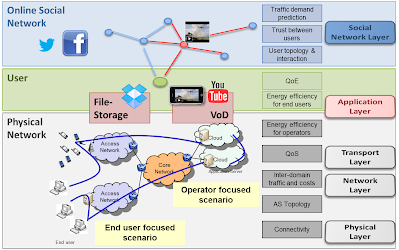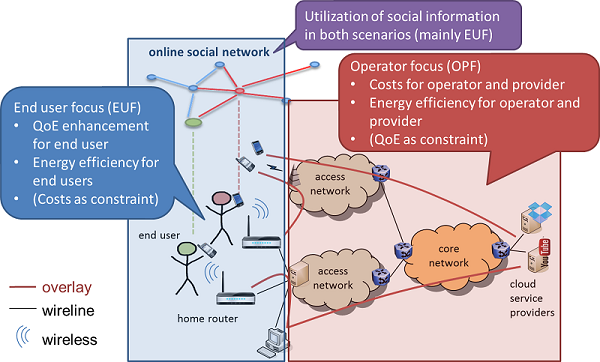During the first year from November 2012 to October 2013, SmartenIT achieved the following major results in the WP1 on “Traffic Measurements and Scenario Definitions”.
- Cloud service classification based on a) Stakeholder characteristics, optimization and intervention potential,
- Cloud service characteristics incl. traffic characteristics
- Application selection for simulations, as well as for trials
- Description and analysis of different scenarios and finally merging and focusing on two key scenarios: from operator and end-user perspective – taking into account QoE and energy efficiency optimization (by means of social-awareness).
By the end of the first year, WP1 successfully concluded and developed the basis for SmartenIT.
Details on Achievements
First, WP1 provided a classification of cloud services and applications which are relevant within SmartenIT framework. The most common and most popular cloud services have been analyzed, classified and ranked to be positioned w.r.t. SmartenIT project main interests and needs. This includes major characteristics of cloud-based overlay applications and services such as traffic volume generated, traffic patterns, energy consumption, QoE aspects, and end-user's devices implications. Additionally, the potential for intervention and optimization w.r.t. traffic, energy and QoE are taken into account. For the identification of application and services to be used to characterize the SmartenIT scenarios, an expert survey in the SmartenIT consortium was conducted to evaluate those criteria for cloud services. For end-users most relevant services in the survey are “File Storage and File Sharing” and “Video on Demand” with Dropbox and YouTube as prominent application examples. For the service enabling technologies “Data Centers” are rated most relevant for SmartenIT.

Second, WP1 reported on recent trends in traffic monitoring and analysis, overviewed most common approaches and concepts related to traffic monitoring, and proposed most practical approaches and open-source applications to perform raw data traffic analysis. Trends for global IP traffic were presented. Moreover the relevance of traffic monitoring to each SmartenIT scenario was identified, as well as an overview of SmartenIT components for traffic monitoring and their potential deployment in SmartenIT ecosystem was given.
Finally, WP1 completed a full and detailed description of the scenarios relevant for the SmartenIT project. In those scenarios, SmartenIT can add value with innovative effective traffic management mechanisms to be developed, identify the involved stakeholders, i.e., network provider, cloud provider, end-users, etc., as well as their interests in terms of cost, traffic, energy and QoE optimization. Therefore, WP1 in SmartenIT analyzed the identified stakeholders' relationships, so as to gain insight on the technical and business dependencies among them, and identify potential for collaboration among them to achieve a mutually beneficial situation.
Four initial scenarios have been described that are (1) Inter-cloud communication, (2) Global service mobility, (3) Exploiting on-line social networks information – Social Awareness, (4) Collaboration for Energy efficiency.With a top-down approach, common macro categories grouping general aspects required for the scenario characterization were identified. Each macro category has been further specialized to allow for a complete and exhaustive characterization of the scenarios with respect to actors and their relationships, as well as technical characteristics and limitations. After having identified overlapping features and synergies across scenarios, a final refinement of scenario description was outlined and two final merged scenarios have been described: operator focused scenario and end-user focused scenario. The two scenarios of the SmartenIT project reflect conceptual differences and complementary segments of the value chain of the Internet services.
Scenarios in SmartenIT
The Internet is rapidly growing in terms of bandwidth and
end-users. This allows for new types of services and applications. These new
types of applications are gaining traction and change the access behavior. As
an example, social networks, cloud services, or messaging applications are
accessed from everywhere on any kind of device, including mobile devices. Thus,
the network infrastructure has to be adapted in order to support this kind of
behavior. A key aspect is the management of these networks in order to manage
the traffic accordingly to fulfill QoE requirements, which may have become more
difficult to fulfill due to roaming users, increasing bandwidth, and dynamic
access behavior. The Internet services provisioning is enabled by means of commercial business agreements among the Internet stakeholders, thus creating a multi-provider and user-centric environment.
SmartenIT targets at an incentive-compatible cross-layer network management for providers of overlay-based application (e.g., cloud applications, content delivery, and social networks), network providers, and end-users to ensure a QoE-awareness, by addressing accordingly load and traffic patterns or special application requirements, and exploiting at the same time social awareness (in terms of user relations and interests). Energy efficiency, on both a per-stakeholder and global basis, comprises an additional important aspect of the SmartenIT approach, which is a holistic optimization approach based on cross-layer optimizations and incentive compatibility for the value chain stakeholders. Therefore, SmartenIT investigates traffic management mechanisms to optimally manage networks for
such dynamic behavior. Besides investigations of social aware management
mechanisms, the mechanisms also need to consider energy efficiency to be able
to analyze the tradeoffs between performance and energy savings. The traffic
management mechanisms and their parameters are chosen specifically to address a
wide range of Quality-of-Experience (QoE) requirements that allow for dynamic
adjustments.

In particular the following two scenarios are developed in SmartenIT: user-focused and operator-focused scenario. The End User Focused Scenario pertains to the services and interactions visible to the end users and the Operator Focused Scenario reflects the wholesale agreements among network and overlay service providers - that though not visible to the end users, greatly affect the Internet services. These two scenarios are also important from a technical point of view since they allow different potential for optimizations and respective traffic mechanisms that operate in different time scales and over different granularities of Internet traffic under a unified framework, the SmartenIT architecture.
End User Focused Scenario
Driven by the end user-focused scenario, SmartenIT
addresses different aspects in the envisioned solution to achieve key goals by
integrating the end-user in the service delivery chain. Note that as seen from
today’s perspective, on the path to the SmartenIT solution, new challenges may
arise, which are not identified today due to the current technological
development of cloud services, but also of the Internet technology itself,
e.g., to monitor energy consumption, Application Programming Interfaces (API)
of cloud services, advance in the deployment of Service-defined Networks (SDN)
concept, or standardization efforts for application layer traffic optimization.
The utilization of existing resources at the end user, i.e. the consumer-grade
Wifi routers with nano data center functionality, allows on one hand offloading
cellular networks and on the other hand storing contents closer to the
consuming users. This will improve QoE compared to traditional traffic
management solutions and will improve energy efficiency for end users as well
as cloud providers. The SmartenIT innovation for the end-used focused scenario
lies in the technical but also conceptual development of a collaborative
traffic management approach with a direct involvement of the end users and
their resources. Proper incentive mechanisms are required which combine
different kind of user contributions to the system, e.g., in terms of Wifi
access or in terms of storage capacity for contents. The SmartenIT solution
provides trustful services by using available social information at the end
user to identify trusted counterparts, e.g., for Wifi access. Further, the
social signals are utilized to improve prediction mechanisms on content
popularity for efficient caching and pre-fetching. In contrast to existing
solutions, the prediction schemes consider different levels of popularity which
are derived from the interaction patterns among the end users in the social
network or observed through the deployed SmartenIT system. Content being
globally popular for many users as well as contents being locally popular
within a certain cluster of users allow fine-granular traffic management and
content placement solutions. For the end-user focused scenario, SmartenIT will
develop an incentive-compatible distributed scalable solution with local decision
engines fed with social signal at the consumer-grade routers. The end-user
focused scenario is therefore mainly considering the retail market in the cloud
SmartenIT ecosystem.
Operator Focused Scenario
In contrast, the operator-focused scenario pertains to the
back end of the Internet services' value chain and captures business
interactions of stakeholders at the wholesale market, which are not directly
revealed to end users. Traffic management at this market typically observes
service-agnostic aggregates of both elastic and inelastic traffic, which are
multiplexed and managed at the aggregate level for achieving scalable
solutions. The SmartenIT innovation in the operator focused scenario is
manifold. First, cloud federation is a newly emerging use case, which aims at
resource sharing between different cloud players, creates new business models
for small or medium cloud/data center operators. Second, the technical
realization of the underlying traffic management processes can be offered as a
service by the Internet Service Providers (ISP) to the operators that want to
form a cloud federation. That “special” traffic management functionality
offered by the ISP eases the communication between operators and minimizes
their costs. In particular, energy efficiency related to the datacenter and to
the ISP infrastructure can be achieved by mobility of resources across the
federation of clouds, driven by previously identified operator needs rather
than driven by end-user actions. SmartenIT solution will be deployed at the
administrative interface that separates data center operator and ISP. The
deployment of SmartenIT solution can be seen as an additional service offered
to ISP/data center operator that will drive data center operator decisions on
content and resource placing. Social awareness will also play a relevant part
to derive actions on traffic management and content placement by triggering
operations among the different actors. However, the level of aggregation, the
granularity and the scope of social information to be used are different than
in the end-user focused scenario. The dynamicity and elasticity of the traffic
management solution, e.g. by combining SDN concepts with SmartenIT solutions,
is another innovative aspect to be expected from the operator focused scenario.
A comparison of both scenarios is provided in the following table.
| Operator focused scenario (OFS) | End user focused scenario (EFS) |
Main actor (main actor under a certain aspect) | Cloud service provider Data center operator Internet service provider (Energy broker) | End user Application provider Internet service provider (Social provider) |
Market | Wholesale market | Retail market |
Key feature | Federation of data center / cloud operators. Interaction between operator and ISP. Mobility of services and contents across federation. Fair optimization of the resources of its infrastructure. May utilize social-awareness. | Mobility of users, services and contents. Will utilize social-awareness. Improved content delivery and placement. Traffic management by allowing for prefetching, caching, and data offloading. |
Major goal of traffic optimization | Costs for operator and provider Energy efficiency for operator and provider (QoE as constraint) | QoE enhancement for end user Energy efficiency also for end users (Costs as constraint) |
SmartenIT solution | Deployed at administrative interfaces separating DC and ISP Additional service offered to ISP/DC | Involvement of end-users in the solution, e.g. via Nano Datacenters Service placement among data centers by ISPs, e.g. via ALTO |